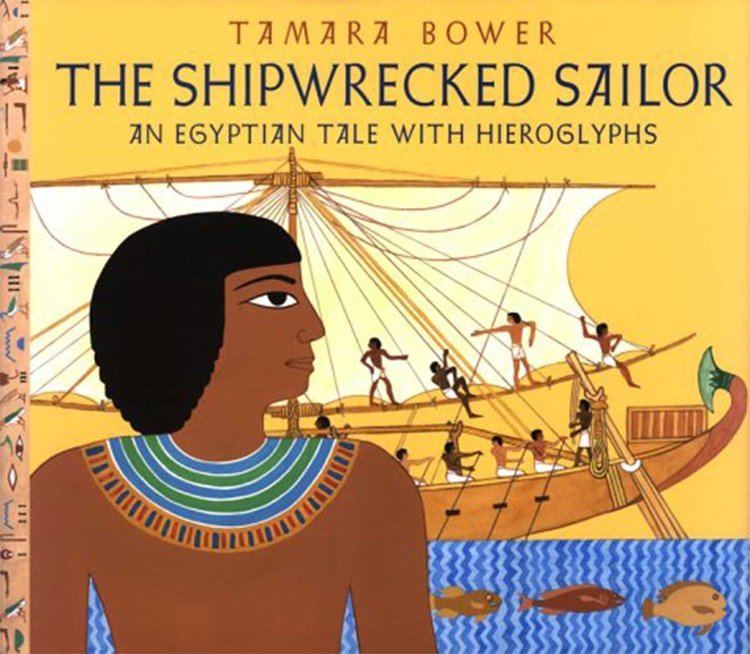 | ||
Similar Tale of Two Brothers, Tale of the doomed prince, Story of Wenamun, Coffin Texts, Egyptian Grammar: Being an | ||
The tale of the shipwrecked sailor
The Tale of the Shipwrecked Sailor is a Middle Kingdom story of an Ancient Egyptian voyage to "the King's mines" .
Contents
- The tale of the shipwrecked sailor
- African literature the tale of the shipwrecked sailor
- Historical information
- Synopsis
- Commentary and analysis
- References
African literature the tale of the shipwrecked sailor
Historical information
At least one source states that the papyrus having the story written upon, was found within the Imperial Museum in St. Petersburg, is located within this museum but that there is no information about where it was originally discovered. Alternatively it is stated that, in fact, Vladimir Golénishcheff discovered the papyrus in 1881 (also stated as a finding originating from the Middle Kingdom).
The name of the scribe who copied it, and who claimed to be "excellent of fingers"(cunning of fingers) despite having made a few slips in the copying,is known as Amenaa, or Ameni-amenna.
Synopsis
The tale begins with a follower (sailor) announcing or stating his return from a voyage at sea. He is returning from an apparently failed expedition and is anxious about how the king will receive him. An attendant reassures him, advising him on how to behave before the king, and repeating the proverb, "The mouth of a man saves him". To encourage his master, he tells a tale of a previous voyage of his in which he overcame disaster, including meeting with a god and the king.
The sailor then describes how his ship, manned by 120 (some translations have 150) sailors, had sunk in a storm and how he alone had survived and was washed up on an island. There he finds shelter and food (he says "there was nothing that was not there"). While making a burnt offering to the gods, he hears thunder and feels the earth shake and sees a giant serpent approach him. The serpent asks him three times who had brought him to the island. When the sailor cannot answer, the serpent takes him to where it lives and asks the question three times more. The sailor repeats his story, now saying that he was on a mission for the king.
The serpent tells him not to fear and that god has let him live and brought him to the island, and that after four months on the island he will be rescued by sailors he knows and will return home. The serpent then relates a tragedy that had happened to him, saying that he had been on the island with 74 of his kin plus a daughter, and that a star fell and "they went up in flames through it". In some translations, the daughter survives; in others, she perishes with the rest. The serpent advises the sailor to be brave and to control his heart, and if he does so, he will return to his family.
The sailor now promises the serpent that he will tell the king of the serpent's power and will send the serpent many valuable gifts, including myrhh and other incense. Laughing at him, the serpent says that the sailor is not rich, but that he (the serpent) is Lord of Punt and that the island is rich in incense, and that when the sailor leaves he will not see the island again as it will become water. The ship arrives and the serpent asks him to "make me a good name in your town" and gives him many precious gifts including spices, incense, elephants' tusks, greyhounds and baboons.
The sailor returns home and gives the king the gifts he took from the island, and the king makes him an attendant and gives him serfs. The tale ends with the master telling the narrator, "Do not make the excellent (that is, do not act arrogant) my friend; why give water to a goose (literally, bird) at dawn before its slaughtering in the morning?"
Commentary and analysis
For some, it is a transparent tale intended as a source of inspiration or reassurance for the noble mind, perhaps similar to something like a courtly creation intended for the royal ear or otherwise for the considering of aristocratic persons. Nevertheless, interpretation of the story has changed from the naive initial understanding of the story as a simplistic tale of the folk tradition, into a sophisticated analysis, developed into which the narrative is shown to have complexity and depth: a shipwrecked traveller engages upon a spiritual endeavour (or quest), journeying through the cosmos, to meet a primordial god, thus providing to the traveller a gift of moral vision to return with to Egypt. Further, Richard Mathews writes that this "oldest fantasy text contains archetypal narrative of the genre: an uninitiated hero on a sea journey is thrown off course by a storm, encounters an enchanted island, confronts a monster, and survives, wiser for the experience," commenting additionally that the monster (snake) is the prototype for "the greatest fantasy monster of all time - the dragon, sometimes called the 'wurm'."
'The tale itself begins with a framing device in which an attendant or "follower" ( conventionally—although not in the papyrus—referred to as "the sailor") tries to comfort his master ("Mayor", although it has been suggested that both might be of equal status), who is returning from an apparently failed expedition and is anxious about how the king will receive him.
